Feasibility of Wave Energy Harvesting in the Ligurian Sea, Italy
Abstract
1. Introduction
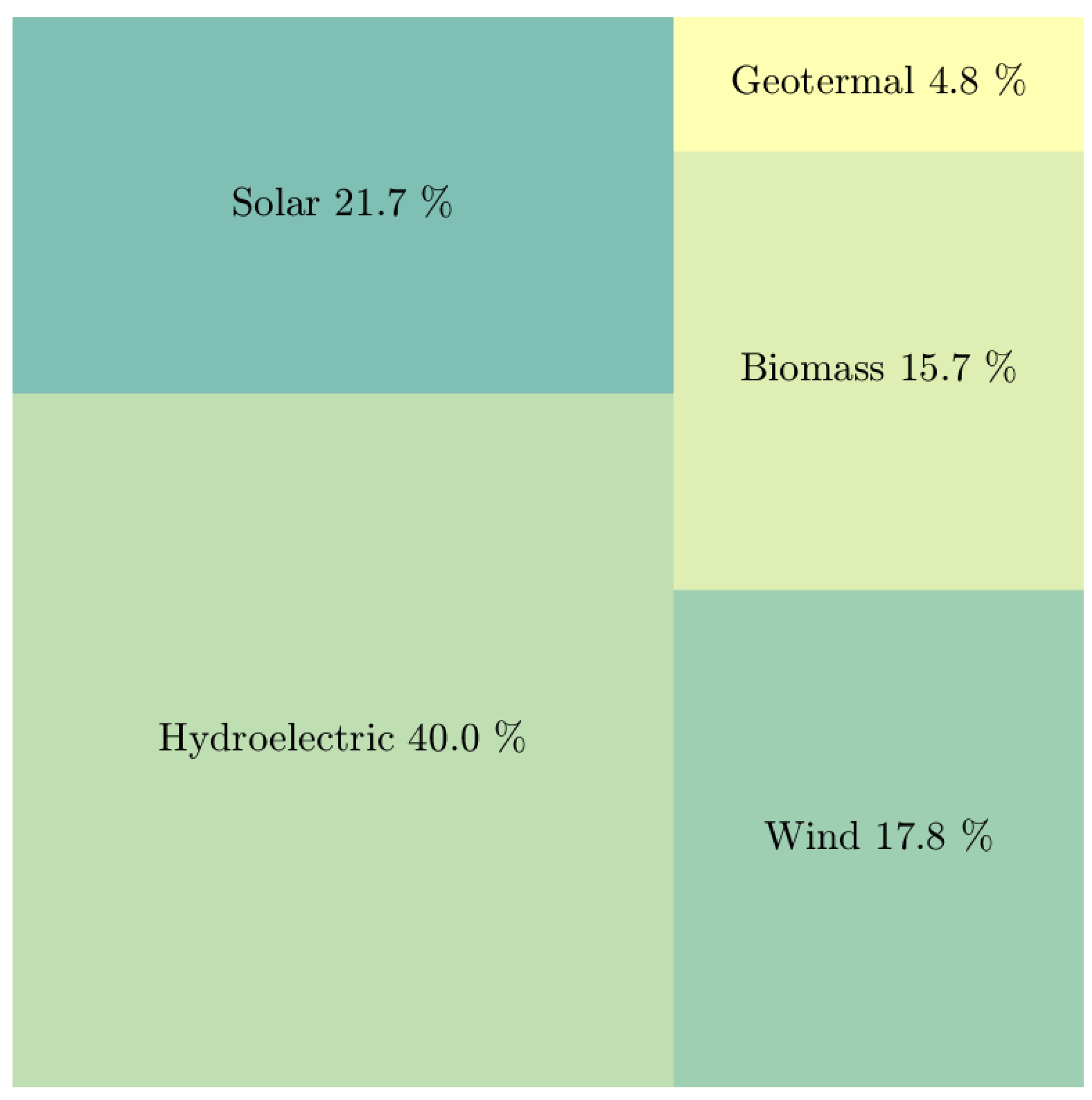
2. Materials and Methods
2.1. Maritime Areas for Wave Energy Exploitation
2.2. Wave Energy Assessment and WEC Performance
2.3. WEC Scaling
2.4. Cost of Energy of the WEC Implementation
- Design and planning of the WEC deployment;
- Cost of the device and power take-off (PTO);
- Transportation, assembly, and installation;
- Electrical controlling system;
- Mooring system;
- Cables.
3. Results
3.1. Wave Energy Assessment
3.2. WEC Scaling and Its Feasibility
4. Discussion and Conclusions
Author Contributions
Funding
Institutional Review Board Statement
Informed Consent Statement
Data Availability Statement
Acknowledgments
Conflicts of Interest
Nomenclature
| AEP | Annual electricity production (MWh per year) |
| CapEx | Capital expenditure (€ per MWh) |
| CF | Capacity factor |
| COE | Cost of energy (€ per MWh) |
| Time duration (hours) | |
| Total energy produced (MWh) | |
| € | Euro |
| EMEC | European Marine Energy Center |
| EVA | Extreme value analysis |
| F-2HB | Floating two-body heavy buoy |
| Froude number | |
| GHG | Greenhouse gases |
| GIS | Geographic Information System |
| GPD | Generalized Pareto distribution |
| Zeroth-order-moment wave height (m) | |
| Maximum wave power (kW/m) | |
| £ | Sterling pound |
| LCOE | Levelized cost of energy (€ per MWh) |
| Scale factor | |
| MRE | Marine renewable energy |
| OpEx | Operational expenditure (€ per MWh) |
| OTEC | Ocean thermal energy conversion |
| OWC | Oscillating water column wave energy converter |
| Nominal rated power (kW) | |
| Power matrix | |
| PTO | Power take-off |
| Wave power (kW/m) | |
| r | Discount rate (%) |
| SIWED | Selection Index for Wave Energy Deployments |
| Wave peak period (s) | |
| Wave energy period (s) | |
| USD $ | United States Dollar |
| WEC | Wave energy converter |
| WEDI | Wave Energy Development Index |
Appendix A. Sources of Geographic Information System
Appendix B. Locations and Features of Wave Energy Converters
| Location | Longitude () | Latitude () | Depth (m) | Distance to the Shoreline (km) |
|---|---|---|---|---|
| 1 | 7.54441 | 43.77087 | 53 | 1.26 |
| 2 | 7.58157 | 43.76901 | 51 | 2.61 |
| 3 | 7.63560 | 43.77343 | 89 | 1.12 |
| 4 | 7.72464 | 43.78236 | 56 | 1.70 |
| 5 | 7.79011 | 43.79527 | 50 | 2.35 |
| 6 | 7.86119 | 43.81292 | 61 | 2.06 |
| 7 | 7.95337 | 43.82901 | 68 | 2.03 |
| 8 | 7.98501 | 43.83958 | 55 | 2.08 |
| 9 | 8.06536 | 43.87079 | 55 | 1.97 |
| 10 | 8.10805 | 43.88967 | 52 | 2.99 |
| 11 | 8.15561 | 43.91685 | 58 | 2.48 |
| 12 | 8.19063 | 43.96788 | 103 | 1.71 |
| 13 | 8.25927 | 44.06441 | 75 | 2.74 |
| 14 | 8.29116 | 44.12218 | 60 | 2.06 |
| 15 | 8.36539 | 44.16223 | 90 | 1.17 |
| 16 | 8.43884 | 44.21363 | 116 | 2.14 |
| 17 | 8.46772 | 44.27304 | 64 | 1.99 |
| 18 | 8.53074 | 44.32048 | 52 | 1.29 |
| 19 | 8.58924 | 44.35409 | 51 | 0.71 |
| 20 | 8.66587 | 44.37254 | 61 | 2.00 |
| 21 | 8.72468 | 44.39703 | 58 | 2.18 |
| 22 | 8.75038 | 44.36038 | 102 | 7.03 |
| 23 | 8.83122 | 44.39960 | 54 | 1.88 |
| 24 | 8.87802 | 44.38630 | 70 | 2.05 |
| 25 | 8.92684 | 44.38100 | 63 | 1.21 |
| 26 | 9.01363 | 44.35465 | 85 | 3.21 |
| 27 | 9.13305 | 44.32701 | 70 | 1.17 |
| 28 | 9.19365 | 44.29541 | 99 | 1.26 |
| 29 | 9.29381 | 44.29624 | 53 | 2.48 |
| 30 | 9.38171 | 44.25016 | 74 | 1.81 |
| 31 | 9.47145 | 44.22088 | 51 | 1.40 |
| 32 | 9.57666 | 44.15170 | 72 | 2.64 |
| 33 | 9.68491 | 44.08329 | 65 | 4.49 |
| 34 | 9.75133 | 44.06773 | 52 | 2.07 |
| 35 | 9.78530 | 43.99765 | 53 | 6.96 |
| 36 | 9.89009 | 43.91506 | 53 | 14.94 |
References
- IEA; IRENA; U.W.B.; WHO. Tracking SDG 7: The Energy Progress Report 2022. 2022. Available online: https://www.worldbank.org/en/topic/energy/publication/tracking-sdg-7-the-energy-progress-report-2022 (accessed on 25 January 2023).
- Bozzi, S.; Archetti, R.; Passoni, G. Wave electricity production in Italian offshore: A preliminary investigation. Renew. Energy 2014, 62, 407–416. [Google Scholar] [CrossRef]
- Kulp, S.A.; Strauss, B.H. New elevation data triple estimates of global vulnerability to sea-level rise and coastal flooding. Nat. Commun. 2019, 10, 4844. [Google Scholar] [CrossRef] [PubMed]
- Pourali, M.; Kavianpour, M.R.; Kamranzad, B.; Alizadeh, M.J. Future variability of wave energy in the Gulf of Oman using a high resolution CMIP6 climate model. Energy 2023, 262, 125552. [Google Scholar] [CrossRef]
- Alessi, A.; Boi, E.; Malkowski, A.; Carlo, C.; Cresci, B.; Zanon, F.; Rana, G.; Furlan, F.; De Marchi, E.; Schiavon, R.; et al. Towards Wave Energy Utilization for Oil and Gas Assets and Wave Farms Development: The Adriatic Sea Demonstration Case. In Proceedings of the Offshore Mediterranean Conference and Exhibition, Ravenna, Italy, 27–29 March 2019. [Google Scholar]
- Lavidas, G. Energy and socio-economic benefits from the development of wave energy in Greece. Renew. Energy 2019, 132, 1290–1300. [Google Scholar] [CrossRef]
- Cornett, A.M. A global wave energy resource assessment. In Proceedings of the Eighteenth International Offshore and Polar Engineering Conference, Vancouver, BC, Canada, 6–11 July 2008. [Google Scholar]
- Sasaki, W. Predictability of global offshore wind and wave power. Int. J. Mar. Energy 2017, 17, 98–109. [Google Scholar] [CrossRef]
- Falcão, A.F.d.O. Wave energy utilization: A review of the technologies. Renew. Sustain. Energy Rev. 2010, 14, 899–918. [Google Scholar] [CrossRef]
- Foteinis, S. Wave energy converters in low energy seas: Current state and opportunities. Renew. Sustain. Energy Rev. 2022, 162, 112448. [Google Scholar] [CrossRef]
- Europe, O.E. Ocean Energy: Key Trends and Statistics 2021. 2022. Available online: https://www.oceanenergy-europe.eu/category/publication-library/ (accessed on 14 January 2023).
- Dal Ferro, B. Wave and tidal energy: Its emergence and the challenges it faces. Refocus 2006, 7, 46–48. [Google Scholar] [CrossRef]
- International Trade Administration. Italy Country Commercial Guide. Available online: https://www.trade.gov/country-commercial-guides/italy-natural-gas-renewable-energy (accessed on 4 March 2023).
- Onea, F.; Rusu, E. Wind energy assessments along the Black Sea basin. Meteorol. Appl. 2014, 21, 316–329. [Google Scholar] [CrossRef]
- Soomere, T.; Eelsalu, M. On the wave energy potential along the eastern Baltic Sea coast. Renew. Energy 2014, 71, 221–233. [Google Scholar] [CrossRef]
- Lavidas, G.; Agarwal, A.; Venugopal, V. Availability and accessibility for offshore operations in the mediterranean sea. Am. Soc. Civ. Eng. 2018, 144, 05018006. [Google Scholar] [CrossRef]
- Liberti, L.; Carillo, A.; Sannino, G. Wave energy resource assessment in the Mediterranean, the Italian perspective. Renew. Energy 2013, 50, 938–949. [Google Scholar] [CrossRef]
- Dialyna, E.; Tsoutsos, T. Wave Energy in the Mediterranean Sea: Resource Assessment, Deployed WECs and Prospects. Energies 2021, 14, 4764. [Google Scholar] [CrossRef]
- Vicinanza, D.; Cappietti, L.; Ferrante, V.; Contestabile, P. Estimation of the wave energy in the Italian offshore. J. Coast. Res. 2011, 64, 613–617. [Google Scholar]
- Vicinanza, D.; Contestabile, P.; Ferrante, V. Wave energy potential in the north-west of Sardinia (Italy). Renew. Energy 2013, 50, 506–521. [Google Scholar] [CrossRef]
- Nezhad, M.M.; Groppi, D.; Rosa, F.; Piras, G.; Cumo, F.; Garcia, D.A. Nearshore wave energy converters comparison and Mediterranean small island grid integration. Sustain. Energy Technol. Assess. 2018, 30, 68–76. [Google Scholar]
- Aristodemo, F.; Ferraro, D.A. Feasibility of WEC installations for domestic and public electrical supplies: A case study off the Calabrian coast. Renew. Energy 2018, 121, 261–285. [Google Scholar] [CrossRef]
- Bozzi, S.; Giassi, M.; Miquel, A.M.; Antonini, A.; Bizzozero, F.; Gruosso, G.; Archetti, R.; Passoni, G. Wave energy farm design in real wave climates: The Italian offshore. Energy 2017, 122, 378–389. [Google Scholar] [CrossRef]
- Bozzi, S.; Besio, G.; Passoni, G. Wave power technologies for the Mediterranean offshore: Scaling and performance analysis. Coast. Eng. 2018, 136, 130–146. [Google Scholar] [CrossRef]
- Van Den Akker, T. Techno-Economic Analysis of Seven Wave Energy Converters and Their Contribution to System Adequacy: A Case Study on Sweden and the UK. Master’s Thesis, Utrecht University, Utrecht, The Netherlands, 2021. Available online: https://studenttheses.uu.nl/handle/20.500.12932/38944 (accessed on 4 March 2023).
- Vicinanza, D.; Margheritini, L.; Kofoed, J.P.; Buccino, M. The SSG wave energy converter: Performance, status and recent developments. Energies 2012, 5, 193–226. [Google Scholar] [CrossRef]
- Iuppa, C.; Cavallaro, L.; Vicinanza, D.; Foti, E. Investigation of suitable sites for wave energy converters around Sicily (Italy). Ocean. Sci. 2015, 11, 543–557. [Google Scholar] [CrossRef]
- Mattiazzo, G. State of the art and perspectives of wave energy in the Mediterranean sea: Backstage of ISWEC. Front. Energy Res. 2019, 7, 114. [Google Scholar] [CrossRef]
- Vannucchi, V.; Cappietti, L. Wave energy assessment and performance estimation of state of the art wave energy converters in Italian hotspots. Sustainability 2016, 8, 1300. [Google Scholar] [CrossRef]
- Simonetti, I.; Cappietti, L. Mediterranean coastal wave-climate long-term trend in climate change scenarios and effects on the optimal sizing of OWC wave energy converters. Coast. Eng. 2023, 179, 104247. [Google Scholar] [CrossRef]
- Majidi, A.; Bingölbali, B.; Akpınar, A.; Iglesias, G.; Jafali, H. Downscaling wave energy converters for optimum performance in low-energy seas. Renew. Energy 2021, 168, 705–722. [Google Scholar] [CrossRef]
- Chozas, J.F.; Kofoed, J.P.; Jensen, N.E.H. User Guide–COE Calculation Tool for Wave Energy Converters: Ver. 1.6-April 2014; Department of Civil Engineering, Aalborg University: Aalborg, Denmark, 2014. [Google Scholar]
- Babarit, A.; Hals, J.; Muliawan, M.J.; Kurniawan, A.; Moan, T.; Krokstad, J. Numerical benchmarking study of a selection of wave energy converters. Renew. Energy 2012, 41, 44–63. [Google Scholar] [CrossRef]
- Day, A.; Babarit, A.; Fontaine, A.; He, Y.P.; Kraskowski, M.; Murai, M.; Penesis, I.; Salvatore, F.; Shin, H.K. Hydrodynamic modelling of marine renewable energy devices: A state of the art review. Ocean. Eng. 2015, 108, 46–69. [Google Scholar] [CrossRef]
- Weatherall, P.; Marks, K.M.; Jakobsson, M.; Schmitt, T.; Tani, S.; Arndt, J.E.; Rovere, M.; Chayes, D.; Ferrini, V.; Wigley, R. A new digital bathymetric model of the world’s oceans. Earth Space Sci. 2015, 2, 331–345. [Google Scholar] [CrossRef]
- Lavidas, G.; Blok, K. Shifting wave energy perceptions: The case for wave energy converter (WEC) feasibility at milder resources. Renew. Energy 2021, 170, 1143–1155. [Google Scholar] [CrossRef]
- Lira-Loarca, A.; Cáceres-Euse, A.; De-Leo, F.; Besio, G. Wave modeling with unstructured mesh for hindcast, forecast and wave hazard applications in the Mediterranean Sea. Appl. Ocean. Res. 2022, 122, 103118. [Google Scholar] [CrossRef]
- Holthuijsen, L.H. Waves in Oceanic and Coastal Waters; Cambridge University Press: Cambridge, UK, 2010. [Google Scholar]
- Holmberg, P.; Andersson, M.; Bolund, B.; Strandanger, K. Wave power-Surveillance study of the development. Elforsk Rapp 2011, 11, 47. [Google Scholar]
- Magagna, D.; Monfardini, R.; Uihlein, A. JRC Ocean Energy Status Report 2016 Edition; Publications Office of the European Union: Luxembourg, 2016. [Google Scholar]
- Dunnett, D.; Wallace, J.S. Electricity generation from wave power in Canada. Renew. Energy 2009, 34, 179–195. [Google Scholar] [CrossRef]
- SeaPowerLtd. Power Matrix of SeaPower Platform. Available online: http://www.seapower.ie/seapower-powermatrix/ (accessed on 11 January 2023).
- SeaPowerLtd. SeaPower Platform—Technology. Available online: http://www.seapower.ie/our-technology/ (accessed on 15 January 2023).
- Tay, Z.Y.; Wei, Y. Power enhancement of pontoon-type wave energy convertor via hydroelastic response and variable power take-off system. J. Ocean. Eng. Sci. 2020, 5, 1–18. [Google Scholar] [CrossRef]
- Sinden, G. Variability of UK Marine Resources; The Carbon Trust: London, UK, 2005. [Google Scholar]
- Weinstein, A.; Fredrikson, G.; Parks, M.; Nielsen, K. AquaBUOY-the offshore wave energy converter numerical modeling and optimization. In Proceedings of the Oceans’ 04 MTS/IEEE Techno-Ocean’04 (IEEE Cat. No. 04CH37600), Kobe, Japan, 9–12 November 2004; Volume 4, pp. 1854–1859. [Google Scholar]
- Clemente, D.; Rosa-Santos, P.; Ferradosa, T.; Taveira-Pinto, F. Wave energy conversion energizing offshore aquaculture: Prospects along the Portuguese coastline. Renew. Energy 2023, 204, 347–358. [Google Scholar] [CrossRef]
- Lavidas, G.; Venugopal, V.; Friedrich, D. Wave energy extraction in Scotland through an improved nearshore wave atlas. Int. J. Mar. Energy 2017, 17, 64–83. [Google Scholar] [CrossRef]
- Lavidas, G. Selection index for Wave Energy Deployments (SIWED): A near-deterministic index for wave energy converters. Energy 2020, 196, 117131. [Google Scholar] [CrossRef]
- Lavidas, G. Developments of energy in EU–unlocking the wave energy potential. Int. J. Sustain. Energy 2019, 38, 208–226. [Google Scholar] [CrossRef]
- De Andres, A.; Medina-Lopez, E.; Crooks, D.; Roberts, O.; Jeffrey, H. On the reversed LCOE calculation: Design constraints for wave energy commercialization. Int. J. Mar. Energy 2017, 18, 88–108. [Google Scholar] [CrossRef]
- Harris, R.E.; Johanning, L.; Wolfram, J. Mooring systems for wave energy converters: A review of design issues and choices. Proc. Inst. Mech. Eng. Part B J. Eng. Manuf. 2004, 220, 159–168. [Google Scholar]
- Bosserelle, C.; Reddy, S.; Krüger, J. Cost Analysis of Wave Energy in the Pacific; Waves and Coasts in the Pacific; Pacific Community (SPC): Suva, Fiji, 2015. [Google Scholar]
- O’Connor, M.; Lewis, T.; Dalton, G. Techno-economic performance of the Pelamis P1 and Wavestar at different ratings and various locations in Europe. Renew. Energy 2013, 50, 889–900. [Google Scholar] [CrossRef]
- Myhr, A.; Bjerkseter, C.; Ågotnes, A.; Nygaard, T.A. Levelised cost of energy for offshore floating wind turbines in a life cycle perspective. Renew. Energy 2014, 66, 714–728. [Google Scholar] [CrossRef]
- Bjerkseter, C.; Ågotnes, A. Levelised Costs of Energy for Offshore Floating Wind Turbine Concepts. Master’s Thesis, Norwegian University of Life Sciences, As, Norway, 2013. [Google Scholar]
- Ocean, S. Ocean Energy: Cost of Energy and Cost Reduction Opportunities; SI OCEAN: Brussels, Belgium, 2013. [Google Scholar]
- Badcock-Broe, A.; Flynn, R.; George, S.; Gruet, R.; Medic, N. Wave and Tidal Energy Market Deployment Strategy for Europe; SI OCEAN: Brussels, Belgium, 2014. [Google Scholar]
- Astariz, S.; Iglesias, G. The economics of wave energy: A review. Renew. Sustain. Energy Rev. 2015, 45, 397–408. [Google Scholar] [CrossRef]
- Astariz, S.; Vazquez, A.; Iglesias, G. Evaluation and comparison of the levelized cost of tidal, wave, and offshore wind energy. J. Renew. Sustain. Energy 2015, 7, 053112. [Google Scholar] [CrossRef]
- Magagna, D.; Uihlein, A. Ocean energy development in Europe: Current status and future perspectives. Int. J. Mar. Energy 2015, 11, 84–104. [Google Scholar] [CrossRef]
- Magagna, D.; Uihlein, A.; Silva, M.; Raventos, A. Wave and Tidal Energy in Europe: Assessing Present Technologies. In Proceedings of the EWTEC 2015: European Wave and Tidal Energy Conference, Nantes, France, 6–11 September 2015. [Google Scholar]
- De Andres, A.; MacGillivray, A.; Guanche, R.; Jeffrey, H. Factors affecting LCOE of Ocean energy technologies: A study of technology and deployment attractiveness. In Proceedings of the International Conference on Ocean Energy, Halifax, NS, Canada, 4–6 November 2014; pp. 4–6. [Google Scholar]
- Lam, P.; Yang, W. Factors influencing the consideration of Public-Private Partnerships (PPP) for smart city projects: Evidence from Hong Kong. Cities 2020, 99, 102606. [Google Scholar] [CrossRef]
- Guo, C.; Sheng, W.; De Silva, D.G.; Aggidis, G. A Review of the Levelized Cost of Wave Energy Based on a Techno-Economic Model. Energies 2023, 16, 2144. [Google Scholar] [CrossRef]
- Pisacane, G.; Sannino, G. Ocean Energy Exploitation in Italy: Ongoing R&D Activities; Position Paper/September 2017; ENEA National Agency for New Technologies, Energy and Sustainable Economic Development: Rome, Italy, 2017. [Google Scholar]
- Cavaleri, L.; Barbariol, F.; Bertotti, L.; Besio, G.; Ferrari, F. The 29 October 2018 storm in Northern Italy: Its multiple actions in the Ligurian Sea. Prog. Oceanogr. 2022, 201, 102715. [Google Scholar] [CrossRef]
- MacGillivray, A.; Jeffrey, H.; Winskel, M.; Bryden, I. Innovation and cost reduction for marine renewable energy: A learning investment sensitivity analysis. Technol. Forecast. Soc. Chang. 2014, 87, 108–124. [Google Scholar] [CrossRef]
- Wang, L.; Zhao, T.; Lin, M.; Li, H. Towards realistic power performance and techno-economic performance of wave power farms: The impact of control strategies and wave climates. Ocean. Eng. 2022, 248, 110754. [Google Scholar] [CrossRef]
- Zanuttigh, B.; Angelelli, E.; Kortenhaus, A.; Koca, K.; Krontira, Y.; Koundouri, P. A methodology for multi-criteria design of multi-use offshore platforms for marine renewable energy harvesting. Renew. Energy 2016, 85, 1271–1289. [Google Scholar] [CrossRef]
- Maienza, C.; Avossa, A.M.; Picozzi, V.; Ricciardelli, F. Feasibility analysis for floating offshore wind energy. Int. J. Life Cycle Assess. 2022, 27, 796–812. [Google Scholar] [CrossRef]
- Klaus, S. Financial and economic assessment of tidal stream energy—a case study. Int. J. Financ. Stud. 2020, 8, 48. [Google Scholar] [CrossRef]
- Langer, J.; Cahyaningwidi, A.A.; Chalkiadakis, C.; Quist, J.; Hoes, O.; Blok, K. Plant siting and economic potential of ocean thermal energy conversion in Indonesia a novel GIS-based methodology. Energy 2021, 224, 120121. [Google Scholar] [CrossRef]
- Piscopo, V.; Benassai, G.; Della Morte, R.; Scamardella, A. Cost-based design and selection of point absorber devices for the mediterranean sea. Energies 2018, 11, 946. [Google Scholar] [CrossRef]
- Giassi, M.; Castellucci, V.; Göteman, M. Economical layout optimization of wave energy parks clustered in electrical subsystems. Appl. Ocean. Res. 2020, 101, 102274. [Google Scholar] [CrossRef]
- Aderinto, T.; Li, H. Review on power performance and efficiency of wave energy converters. Energies 2019, 12, 4329. [Google Scholar] [CrossRef]

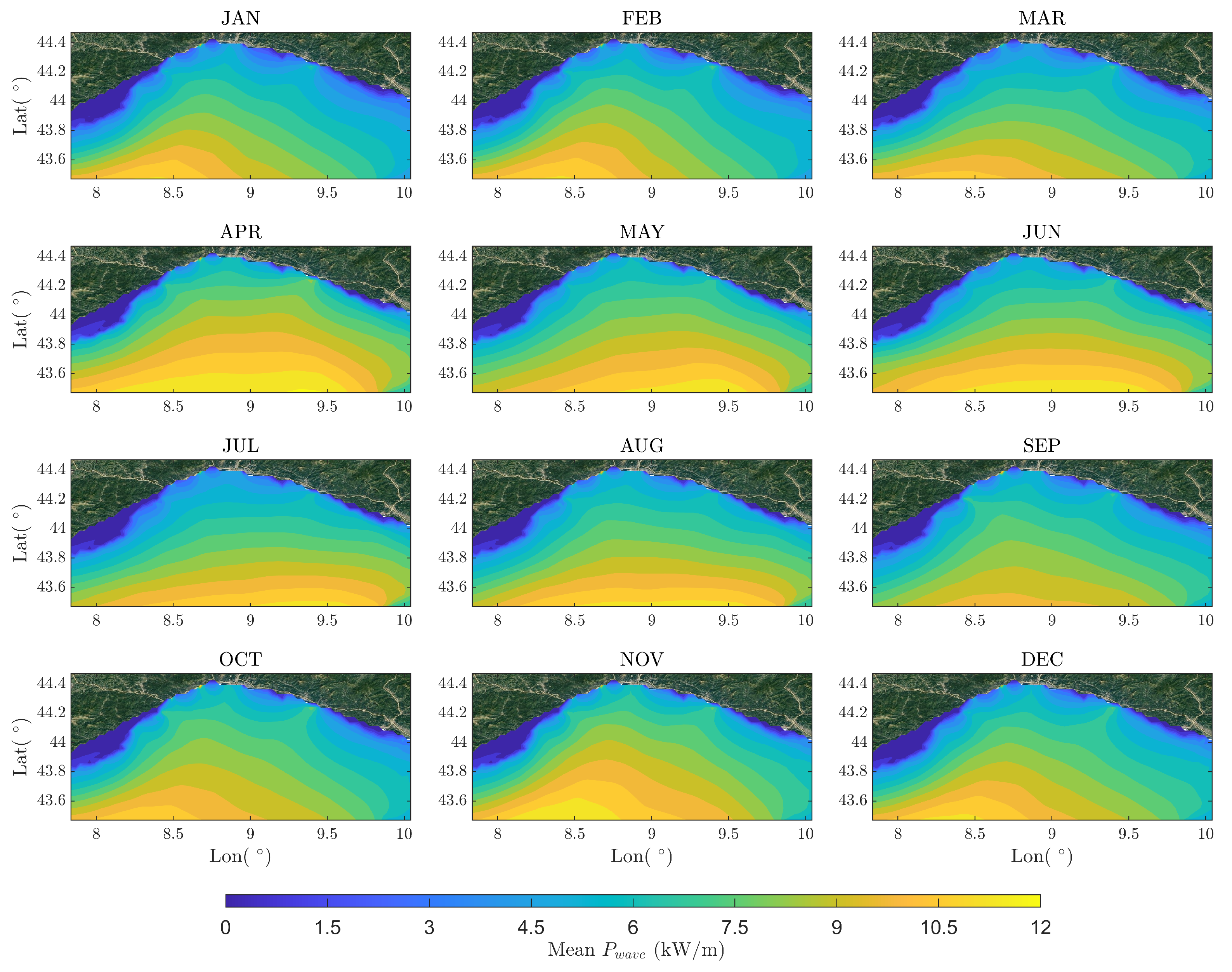
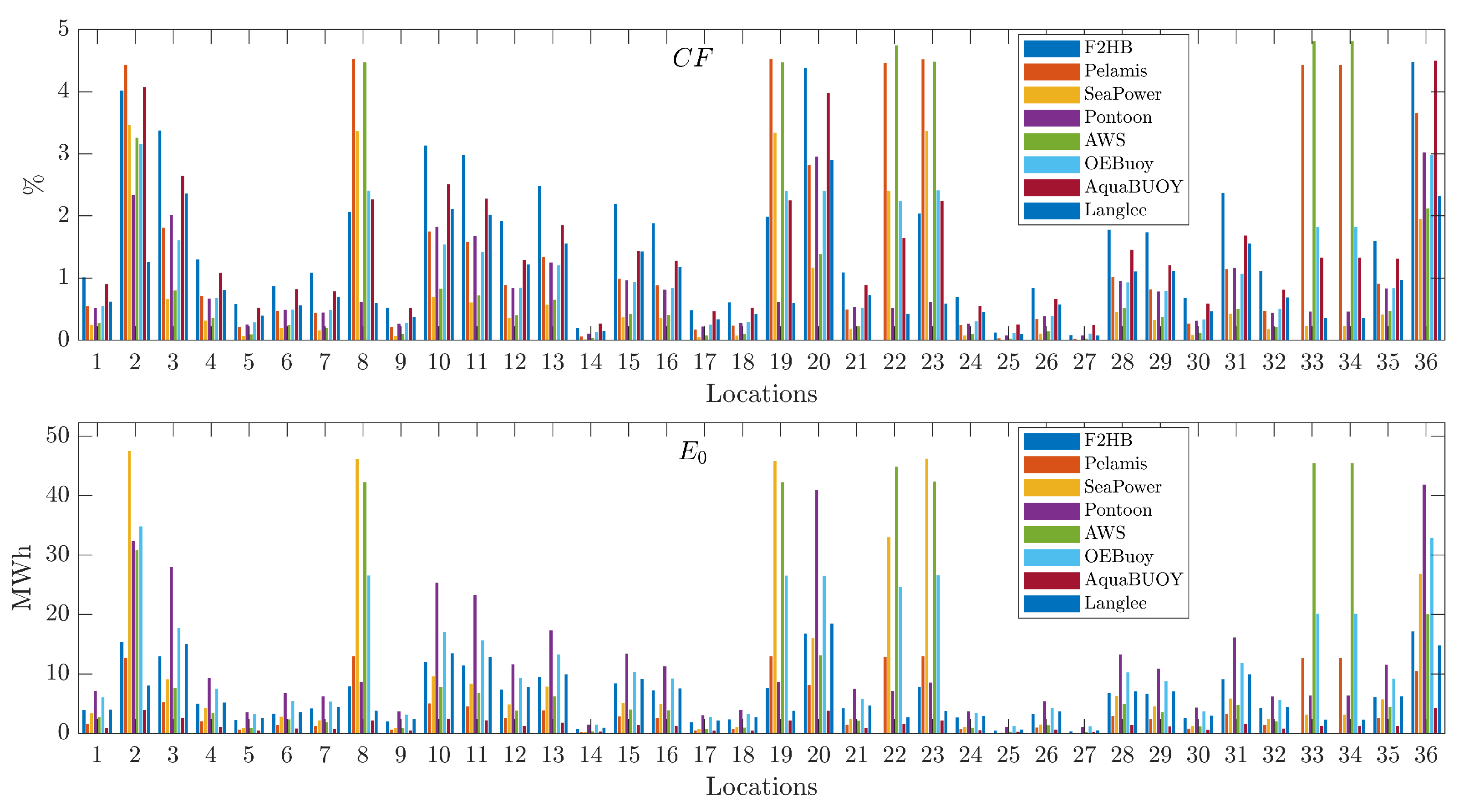

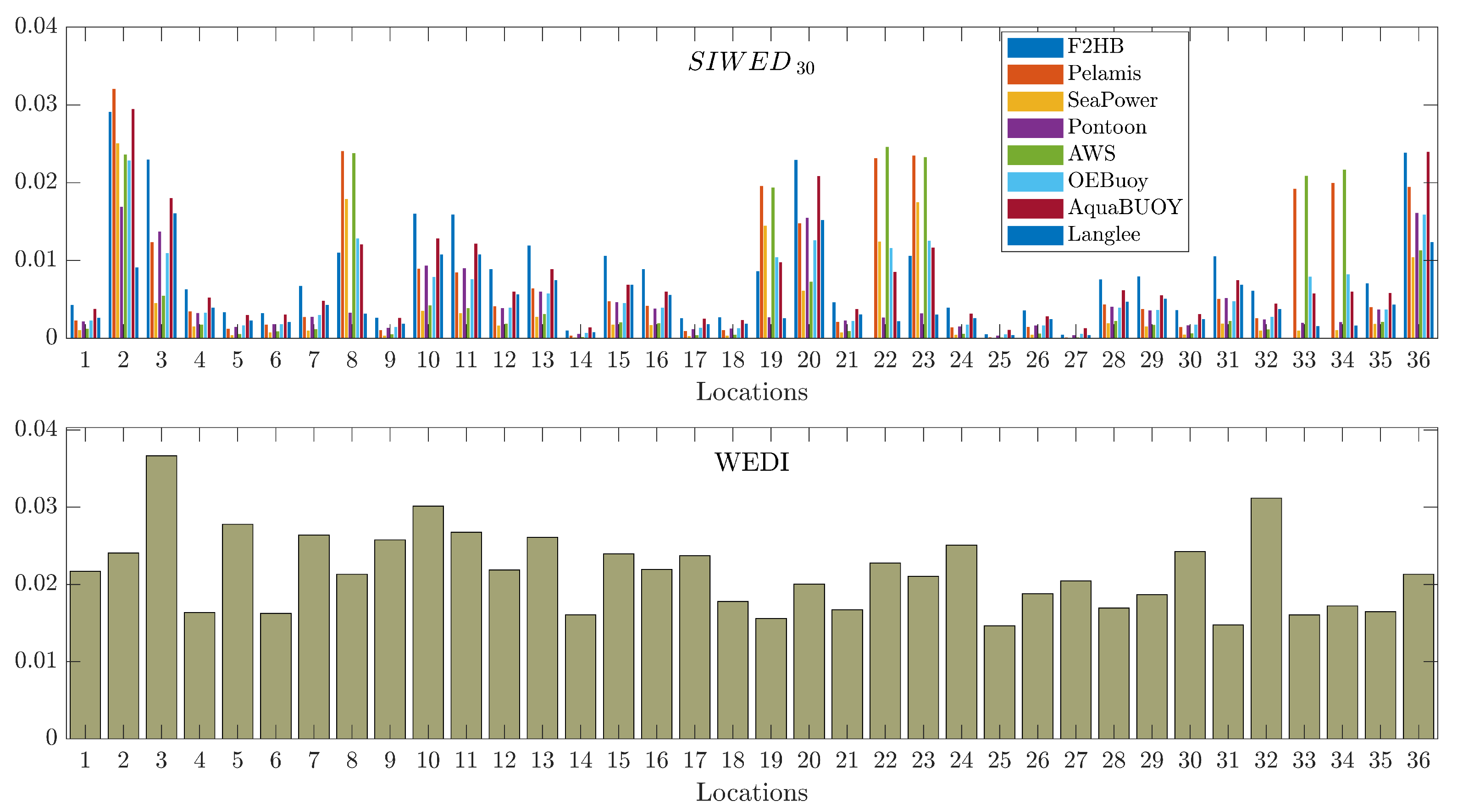
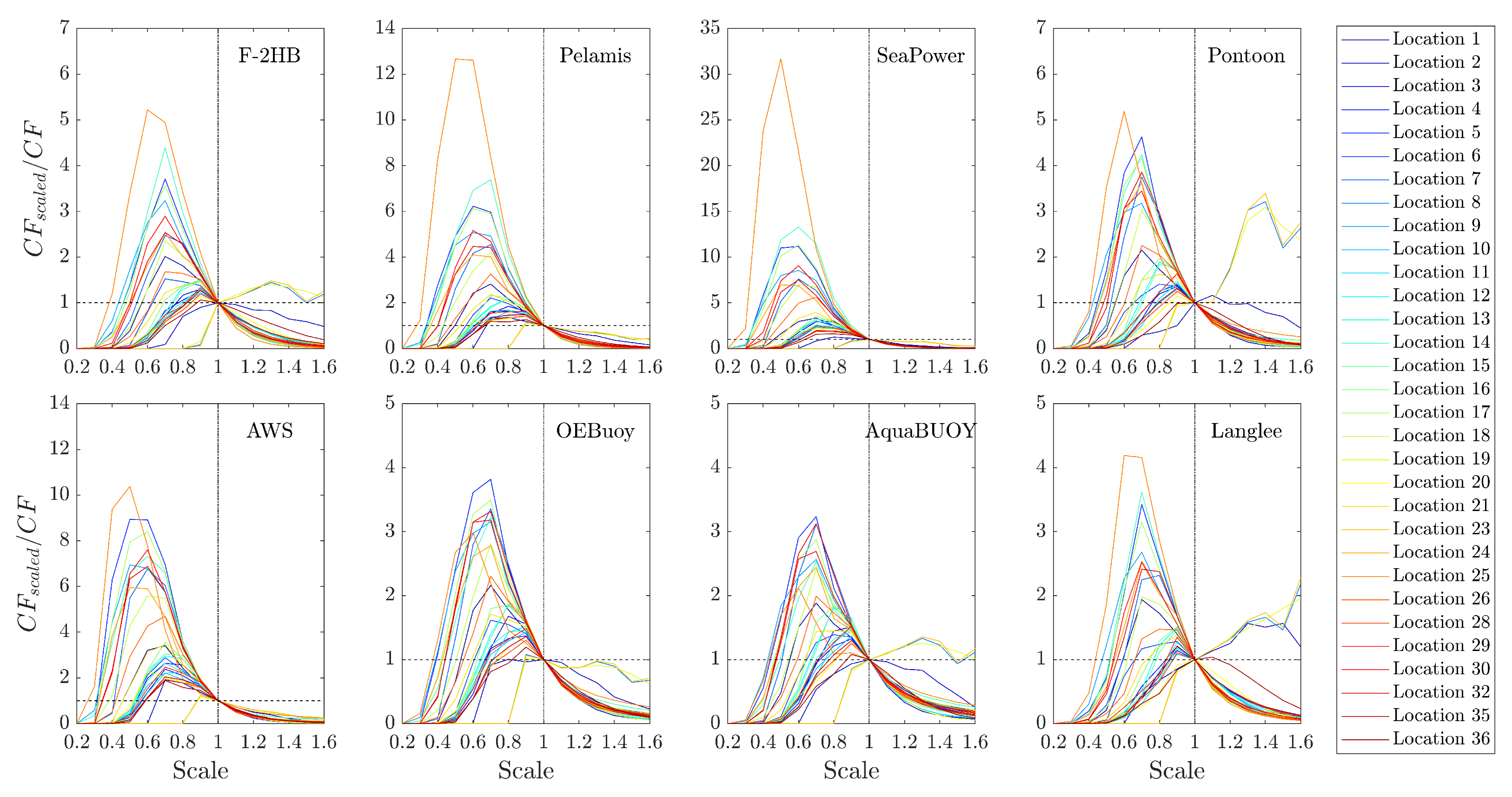



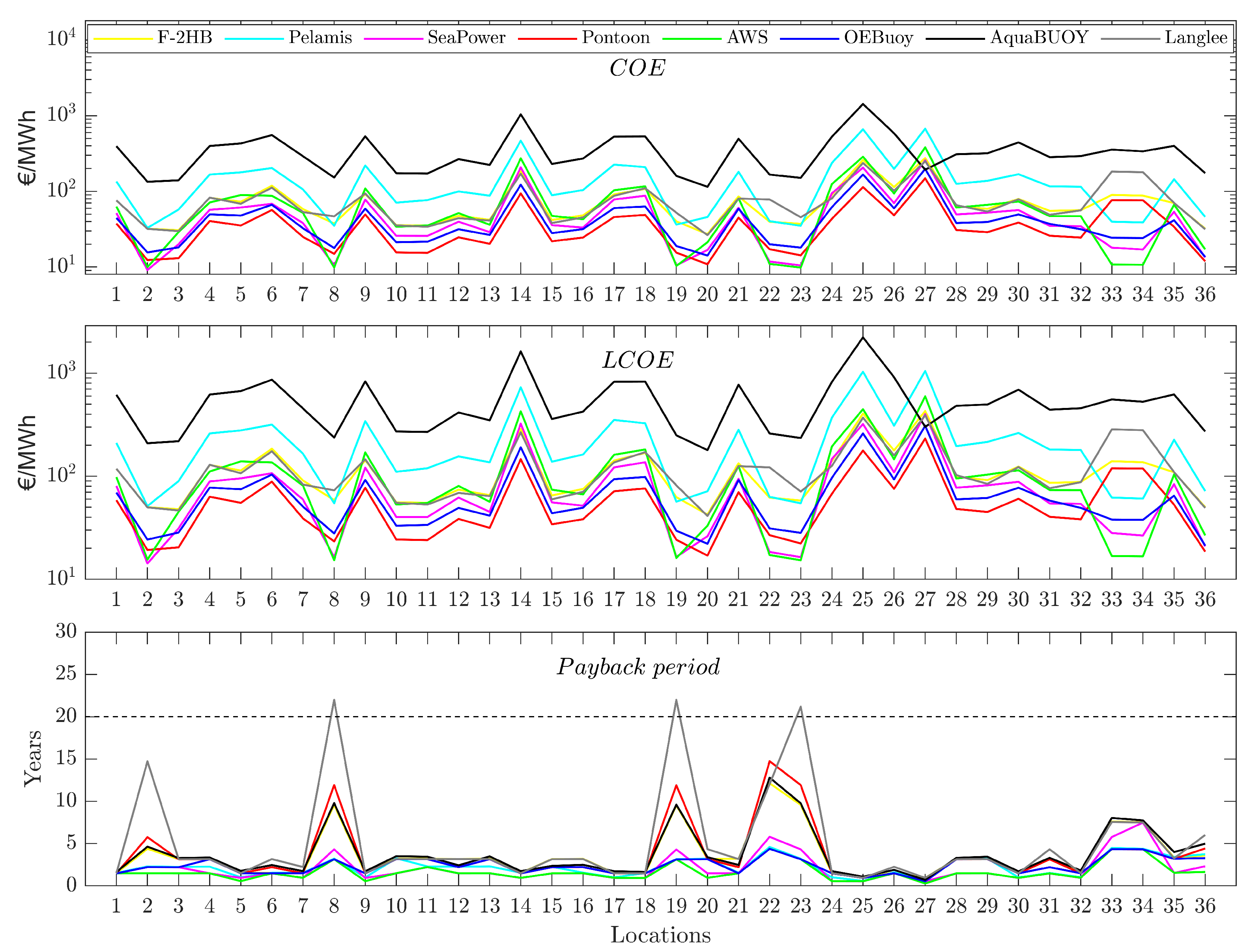
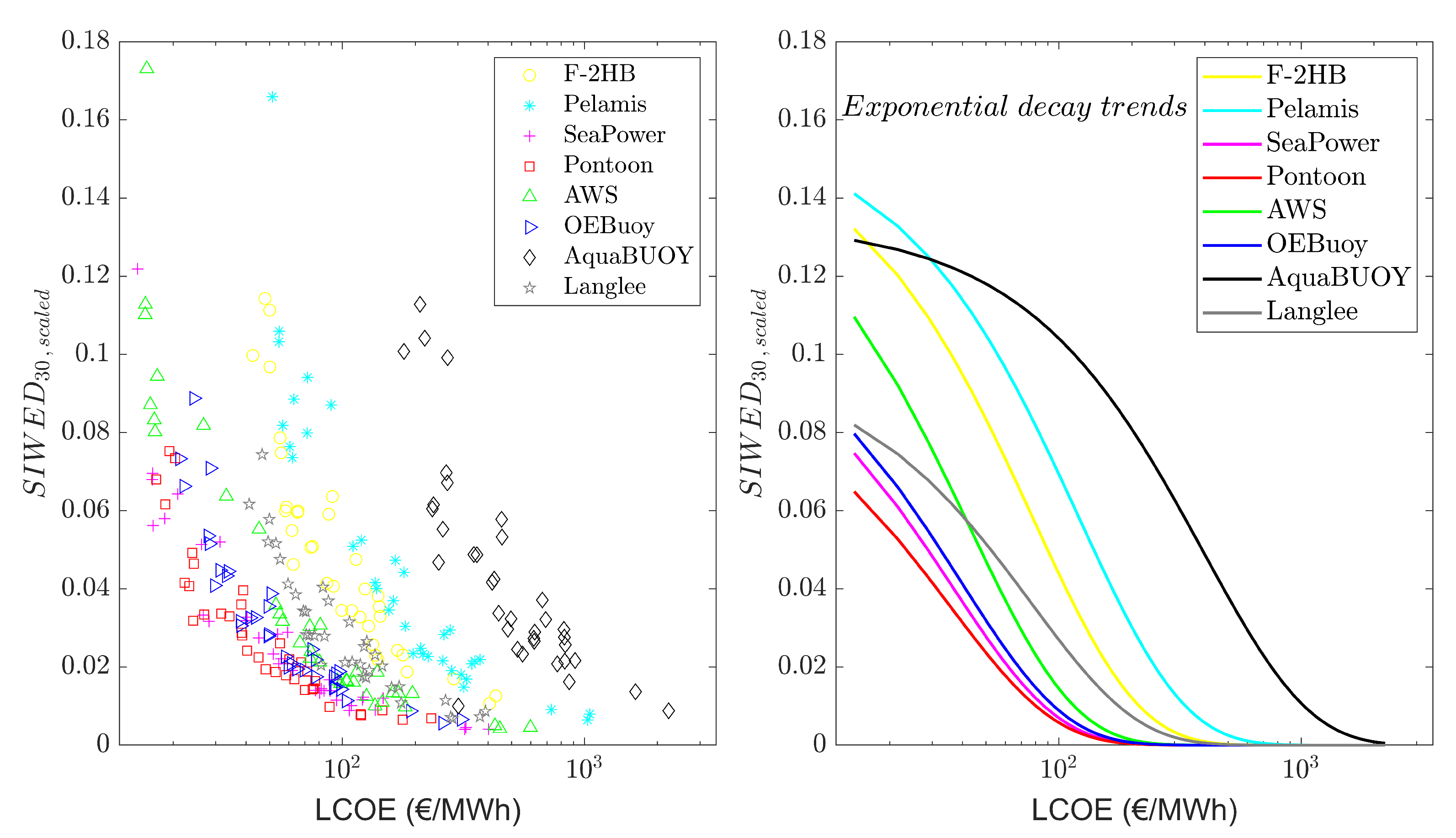
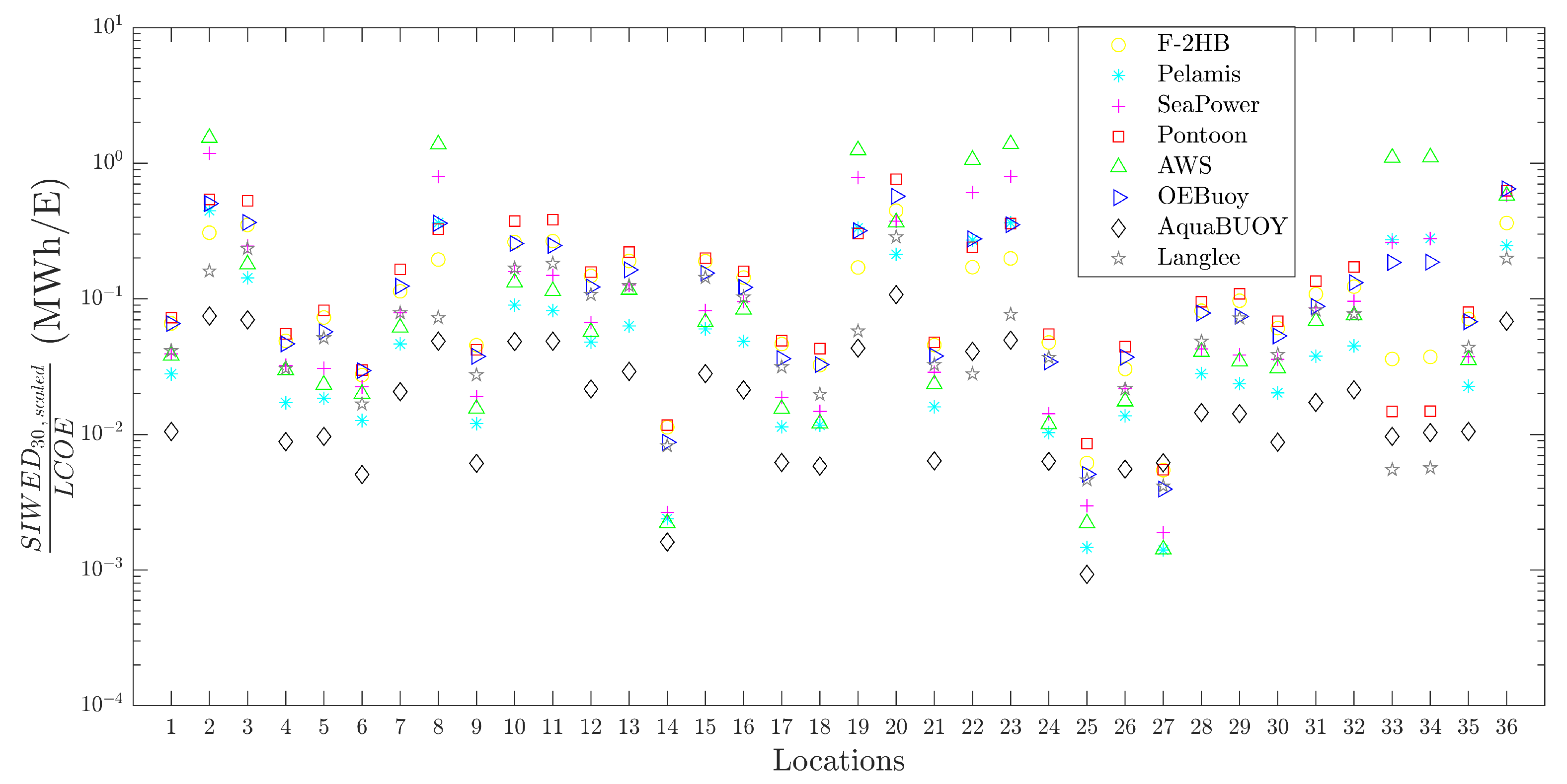
| Wave Converter | Size | Installation Depth | Power Take Off | Rated Power |
|---|---|---|---|---|
| F-2HB [33] | Characteristic area 2120 m2 | 40–150 m | Hydraulic PTO system driven by 2 bodies | 1000 kW |
| Pelamis [41] | 150 m long, 3.5 m diameter | >50 m | High-pressure hydraulic motors and electrical generators | 750 kW |
| SeaPower [42,43] | Characteristic length 40 feet | >50 m | Hydraulic motor/pump | 3587 kW |
| Pontoon [33,44] | Characteristic area 4800 m2 | >50 m | High-head water turbine | 3619 kW |
| AWS [45] | 7 m height, 4 m diameter | >25 m | Linear generator | 2470 kW |
| OEbuoy [33] | Characteristic area 6500 m2 | Deep waters | Bidirectional air turbine | 2880 kW |
| AquaBUOY [46,47] | Float diameter 6 m | 150–250 feet | High-head water turbine | 250 kW |
| Langlee [33] | Characteristic area 2160 m2 | 40–150 m | Relative motion between four hinged flaps | 1500 kW |
| Parameter | Scale Relationship |
|---|---|
| Development | |
| Main frame and second frame | It is calculated based on on the weight of materials selected |
| Access system and platform | |
| Machine housing | |
| Total load carrying structure | |
| PTO | |
| Generator | |
| Power electronics | |
| Control and safety system | |
| Total power take-off system | |
| Mooring system | |
| Pre-assembly and transport | |
| Installation on site | |
| Electrical connection | |
| Contingencies | Same values as reference machine |
| Operation and maintenance per year | Scaled by: Total el. production scaled machine/Total el. production reference machine |
| Others |
| Item | Unit | Year | Reference | Present Cost | Unit | |
|---|---|---|---|---|---|---|
| PTO | 800 | €/kW | 2000 | [51] | 1052.55 | €/kW |
| Mooring system | 250 | £/m | 2000 | [52] | 371.68 | €/m |
| Pre-assembly and transportation | 10,000 | £ | 2017 | [51] | 12,138.40 | € |
| Installation | 33 | % of WEC cost | 2015 | [53] | 33 | % of WEC cost |
| Cables | 100 | £/m | 2000 | [54] | 148.67 | €/m |
| Cost of steel | 1.6 | £/kg | 2014 | [55] | 2.01 | €/kg |
| Electrical connection | 5 | % of WEC cost | 2015 | [53] | 5.00 | % of WEC cost |
| Development | 3 | % of CapEx | 2014 | [32] | 2.1 | % of CapEx |
| Construction phase insurance | 17,500,000 | €/MW | 2013 | [56] | 19,717,106.11 | €/MW |
| Operations and maintenance costs (OM) | 10–30% | % of CapEx | 2014 | [40,57,58,59,60,61,62] | 8 | % of CapEx |
| F-2HB | 830.37 | US $/MW | 2015 | [63] | 855.14 | €/MW |
| Pelamis | 4666.67 | US $/MW | 2015 | [53] | 4748.90 | €/MW |
| SeaPower | 542.08 | US $/MW | 2014 | [63] | 558.25 | €/MW |
| Pontoon | 107.46 | US $/MW | 2014 | [63] | 110.66 | €/MW |
| AWS | 209.93 | US $/MW | 2014 | [63] | 216.19 | €/MW |
| OEBuoy | 180.04 | US $/MW | 2014 | [63] | 185.41 | €/MW |
| AquaBUOY | 13,827.16 | US $/MW | 2014 | [63] | 14,239.65 | €/MW |
| Langlee | 3989.75 | US $/MW | 2014 | [63] | 4108.78 | €/MW |
| Location | F-2HB | Pelamis | SeaPower | Pontoon | AWS | OEBuoy | AquaBUOY | Langlee |
|---|---|---|---|---|---|---|---|---|
| 1 | 0.7 | 0.7 | 0.7 | 0.7 | 0.7 | 0.7 | 0.7 | 0.7 |
| 2 | 1.0 | 0.8 | 0.8 | 1.1 | 0.7 | 0.8 | 1.0 | 1.5 |
| 3 | 0.9 | 0.8 | 0.8 | 0.9 | 0.7 | 0.8 | 0.9 | 0.9 |
| 4 | 0.9 | 0.8 | 0.7 | 0.9 | 0.7 | 0.9 | 0.9 | 0.9 |
| 5 | 0.7 | 0.6 | 0.6 | 0.7 | 0.5 | 0.7 | 0.7 | 0.7 |
| 6 | 0.7 | 0.7 | 0.7 | 0.8 | 0.7 | 0.7 | 0.8 | 0.9 |
| 7 | 0.7 | 0.7 | 0.6 | 0.7 | 0.6 | 0.7 | 0.7 | 0.8 |
| 8 | 1.3 | 0.9 | 1.0 | 1.4 | 0.9 | 0.9 | 1.3 | 1.6 |
| 9 | 0.7 | 0.6 | 0.6 | 0.7 | 0.5 | 0.7 | 0.7 | 0.7 |
| 10 | 0.9 | 0.9 | 0.7 | 0.9 | 0.7 | 0.9 | 0.9 | 0.9 |
| 11 | 0.9 | 0.8 | 0.8 | 0.9 | 0.8 | 0.9 | 0.9 | 0.9 |
| 12 | 0.9 | 0.8 | 0.7 | 0.8 | 0.7 | 0.8 | 0.8 | 0.9 |
| 13 | 0.9 | 0.8 | 0.7 | 0.9 | 0.7 | 0.9 | 0.9 | 0.9 |
| 14 | 0.7 | 0.7 | 0.6 | 0.7 | 0.6 | 0.7 | 0.7 | 0.7 |
| 15 | 0.9 | 0.8 | 0.7 | 0.8 | 0.7 | 0.8 | 0.8 | 0.9 |
| 16 | 0.9 | 0.7 | 0.7 | 0.8 | 0.7 | 0.8 | 0.8 | 0.9 |
| 17 | 0.7 | 0.6 | 0.6 | 0.7 | 0.6 | 0.7 | 0.7 | 0.7 |
| 18 | 0.7 | 0.7 | 0.6 | 0.7 | 0.6 | 0.7 | 0.7 | 0.7 |
| 19 | 1.3 | 0.9 | 1.0 | 1.4 | 0.9 | 0.9 | 1.3 | 1.6 |
| 20 | 0.9 | 0.9 | 0.7 | 0.9 | 0.6 | 0.9 | 0.9 | 1.0 |
| 21 | 0.9 | 0.7 | 0.7 | 0.8 | 0.7 | 0.7 | 0.8 | 0.9 |
| 22 | 1.4 | 1.0 | 1.1 | 1.5 | 1.0 | 1.0 | 1.4 | 1.4 |
| 23 | 1.3 | 0.9 | 1.0 | 1.4 | 0.9 | 0.9 | 1.3 | 1.6 |
| 24 | 0.7 | 0.6 | 0.5 | 0.7 | 0.5 | 0.7 | 0.7 | 0.7 |
| 25 | 0.6 | 0.5 | 0.5 | 0.6 | 0.5 | 0.6 | 0.6 | 0.6 |
| 26 | 0.7 | 0.7 | 0.7 | 0.7 | 0.7 | 0.7 | 0.7 | 0.8 |
| 27 | 0.6 | 0.5 | 0.5 | 0.5 | 0.4 | 0.5 | 0.5 | 0.6 |
| 28 | 0.9 | 0.9 | 0.7 | 0.9 | 0.7 | 0.9 | 0.9 | 0.9 |
| 29 | 0.9 | 0.9 | 0.7 | 0.9 | 0.7 | 0.9 | 0.9 | 0.9 |
| 30 | 0.7 | 0.6 | 0.6 | 0.7 | 0.6 | 0.7 | 0.7 | 0.7 |
| 31 | 0.9 | 0.7 | 0.7 | 0.9 | 0.7 | 0.8 | 0.9 | 1.0 |
| 32 | 0.7 | 0.6 | 0.6 | 0.7 | 0.6 | 0.7 | 0.7 | 0.7 |
| 33 | 1.2 | 1.0 | 1.1 | 1.0 | 1.0 | 1.0 | 1.2 | 1.2 |
| 34 | 1.2 | 1.0 | 1.2 | 1.0 | 1.0 | 1.0 | 1.2 | 1.2 |
| 35 | 0.9 | 0.9 | 0.7 | 0.9 | 0.7 | 0.9 | 0.9 | 0.9 |
| 36 | 0.9 | 0.9 | 0.8 | 1.0 | 0.7 | 0.9 | 0.9 | 1.1 |
| Location | Optimal WEC | Location | Optimal WEC | Location | Optimal WEC | Location | Optimal WEC |
|---|---|---|---|---|---|---|---|
| 1 | Pontoon (0.7) | 10 | Pontoon (0.9) | 19 | AWS (0.9) | 28 | Pontoon (0.9) |
| 2 | AWS (0.7) | 11 | Pontoon (0.9) | 20 | Pontoon (0.9) | 29 | Pontoon (0.9) |
| 3 | Pontoon (0.9) | 12 | Pontoon (0.8) | 21 | Pontoon (0.8) | 30 | Pontoon (0.7) |
| 4 | Pontoon (0.9) | 13 | Pontoon (0.9) | 22 | AWS (1) | 31 | Pontoon (0.9) |
| 5 | Pontoon (0.7) | 14 | Pontoon (0.7) | 23 | AWS (0.9) | 32 | Pontoon (0.7) |
| 6 | Pontoon (0.8) | 15 | Pontoon (0.8) | 24 | Pontoon (0.7) | 33 | AWS (1) |
| 7 | Pontoon (0.7) | 16 | Pontoon (0.8) | 25 | Pontoon (0.6) | 34 | AWS (1) |
| 8 | AWS (0.9) | 17 | Pontoon (0.7) | 26 | Pontoon (0.7) | 35 | Pontoon (0.9) |
| 9 | F-2HB (0.7) | 18 | Pontoon (0.7) | 27 | AquaBUOY (0.5) | 36 | OEBuoy (0.9) |
Disclaimer/Publisher’s Note: The statements, opinions and data contained in all publications are solely those of the individual author(s) and contributor(s) and not of MDPI and/or the editor(s). MDPI and/or the editor(s) disclaim responsibility for any injury to people or property resulting from any ideas, methods, instructions or products referred to in the content. |
© 2023 by the authors. Licensee MDPI, Basel, Switzerland. This article is an open access article distributed under the terms and conditions of the Creative Commons Attribution (CC BY) license (https://creativecommons.org/licenses/by/4.0/).
Share and Cite
Corrales-Gonzalez, M.; Lavidas, G.; Besio, G. Feasibility of Wave Energy Harvesting in the Ligurian Sea, Italy. Sustainability 2023, 15, 9113. https://doi.org/10.3390/su15119113
Corrales-Gonzalez M, Lavidas G, Besio G. Feasibility of Wave Energy Harvesting in the Ligurian Sea, Italy. Sustainability. 2023; 15(11):9113. https://doi.org/10.3390/su15119113
Chicago/Turabian StyleCorrales-Gonzalez, Manuel, George Lavidas, and Giovanni Besio. 2023. "Feasibility of Wave Energy Harvesting in the Ligurian Sea, Italy" Sustainability 15, no. 11: 9113. https://doi.org/10.3390/su15119113
APA StyleCorrales-Gonzalez, M., Lavidas, G., & Besio, G. (2023). Feasibility of Wave Energy Harvesting in the Ligurian Sea, Italy. Sustainability, 15(11), 9113. https://doi.org/10.3390/su15119113









